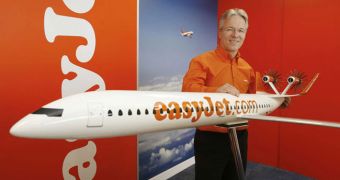Because we do not see it, it is less obvious for us, but aircrafts expel a lot of greenhouse gases into the atmosphere.
A 2004 NASA survey showed a 1 % per decade increase in cirrus cloud cover over the US, linked to intense air travel. Jets leave behind condensation trails, indistinguishable from clouds, and the extra cloudiness is blamed for a temperature rise of 0.5? F (0.27? C) per decade in the period between 1975 and 1994. Now, British low-cost airline easyJet has announced the development of a new type of short-haul airliner designed to be highly environmentally friendly.
The "easyJet ecoJet" will be ready by 2015, and it will be 25 % quieter, emitting 50 % less carbon dioxide (CO2) and 75 % less nitrous oxide (NO and NO2) than current models.
"The lightweight structure and open-rotor engines are based on technologies that are being developed right now by the major manufacturers. The easyJet ecoJet is realistic and it is achievable. If the easyJet ecoJet were to be made available today, we would order hundreds [of] them for fleet replacement and to achieve the 'green growth' that our industry has committed to," said Andy Harrison, easyJet's chief executive.
The ecoJet's engines will expel 25 % less CO2 and its lightweight airframe will save 15 % of the consumption, while the better air traffic control technology and design will count for the remaining 10 % decrease (meaning 47 grams less CO2 less per passenger kilometer).
Current easyJet's models generate 97.5 grams of CO2 per passenger kilometer and the Toyota Prius emits 104 grams. European car industry has recently targeted a hint of maximum 130 grams of CO2 per kilometer.
Today's most common short-haul airliners are the Airbus A320 and the Boeing 737 families. Their popularity makes some customers receive their new jets for another seven years.
The A319, a member of the Airbus A320 family, is numerically the most important aircraft type in easyJet's fleet. EasyJet encountered great difficulties in fixing large rear-mounted "open-rotor" engines (unducted fans) under the wings of a narrow-body aircraft, so that rear-mounting would be the best solution. The design displays a lower cruise speed to decrease drag and a shorter range to reduce weight.
A gear box between the engine and the open-rotor blades will keep subsonic the speed at which the blade tips will rotate during take-off and landing, decreasing engine noise.
The engines placed above the ecoJet's tailplanes and tailfins will protect the ground from engine noise. No slats on the leading edge of the wing will also reduce noise. The ecoJet could drop emissions from short-haul airline at 2005 levels until 2035.
"The aviation industry has an excellent record in reducing the environmental footprint of aircraft. Today's aircraft are typically 70 % cleaner and 75 % quieter than their 1960s counterparts. Now we are planning the next generation that will help towards taking the plane out of the emissions equation," said Harrison.

 14 DAY TRIAL //
14 DAY TRIAL //